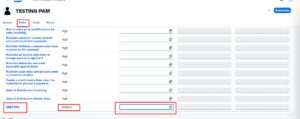SAP Identity Access Governance (IAG) is a cloud-based solution that helps organizations to manage the lifecycle of user access and roles across their SAP and non-SAP systems. IAG enables organizations to comply with internal and external regulations, reduce security risks, and optimize business processes. However, like any other IT solution, IAG also involves some potential risks that need to be identified, assessed, and mitigated. This document provides a brief overview of how to perform risk mitigation in IAG using the following steps:
- Identify the sources and types of risks.
- Assess the impact and likelihood of risks.
- Define and implement risk mitigation strategies.
- Monitor and review the effectiveness of risk mitigation.
Identify the sources and types of risks.
The first step in risk mitigation is to identify the sources and types of risks that may affect the IAG solution. The sources of risks can be internal or external, such as:
- Changes in business requirements or processes
- Changes in regulatory or legal requirements
- Changes in technology or infrastructure
- Human errors or malicious actions
- Natural disasters or cyberattacks.
The types of risks can be categorized into four domains, according to the COBIT framework:
- Strategic risks: risks that affect the alignment of IAG with the business goals and objectives.
- Operational risks: risks that affect the performance and efficiency of IAG processes and activities.
- Compliance risks: risks that affect the adherence of IAG to internal and external standards and regulations.
- Information risks: risks that affect the confidentiality, integrity, and availability of IAG data and information.
Assess the impact and likelihood of risks.
The second step in risk mitigation is to assess the impact and likelihood of risks that have been identified. The impact of risks refers to the potential consequences or damages that may result from the occurrence of risks. The likelihood of risks refers to the probability or frequency of risks occurring. The impact and likelihood of risks can be measured using qualitative or quantitative methods, such as:
- Rating scales: assigning numerical or descriptive values to the impact and likelihood of risks, such as low, medium, high, or very high.
- Scoring models: applying mathematical formulas or algorithms to calculate the impact and likelihood of risks, such as risk score = impact x likelihood
- Decision matrices: using tables or charts to compare and prioritize the impact and likelihood of risks, such as risk matrix = impact (rows) x likelihood (columns)
Define and implement risk mitigation strategies.
The third step in risk mitigation is to define and implement risk mitigation strategies that aim to reduce the impact and likelihood of risks. The risk mitigation strategies can be classified into four types, according to the ISO 31000 standard:
- Avoid: eliminating the source of risk or changing the plan or activity that causes the risk
- Reduce: minimizing the impact or likelihood of risk by implementing controls or safeguards
- Share: transferring or sharing the risk with another party, such as a vendor or a partner
- Accept: retaining the risk and preparing for the consequences, such as contingency plans or reserves
The choice of risk mitigation strategy depends on the level of risk tolerance and the cost-benefit analysis of each option. The risk mitigation strategy should be documented and communicated to the relevant stakeholders, such as the IAG project team, the business owners, and the auditors.
Monitor and review the effectiveness of risk mitigation.
The fourth and final step in risk mitigation is to monitor and review the effectiveness of risk mitigation strategies that have been implemented. The monitoring and review process involves collecting and analysing data and information related to the risk mitigation activities, such as:
- Risk indicators: metrics or measures that indicate the status or performance of risk mitigation, such as risk score, risk level, or risk trend.
- Risk reports: documents or dashboards that summarize and visualize the risk indicators and provide insights and recommendations.
- Risk audits: independent assessments or evaluations that verify and validate the risk mitigation processes and outcomes.
The monitoring and review process should be conducted regularly and periodically, depending on the nature and dynamics of the risks. The monitoring and review process should also provide feedback and suggestions for improvement and adjustment of the risk mitigation strategies, if needed.
Here is the process of risk mitigation in SAP IAG
- Risk Identification, Risk Analysis


2. Risk Treatment through remediation process







